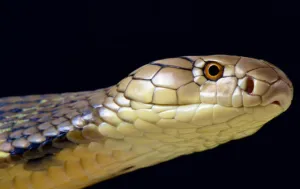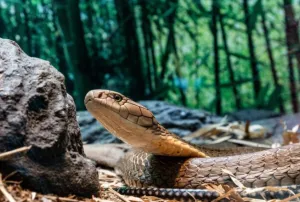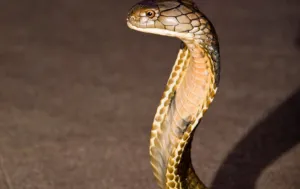
Table of Contents
Scientific Classification
- Kingdom: Animalia
- Phylum: Chordata
- Class: Reptilia
- Order: Squamata
- Suborder: Serpentes
- Family: Elapidae
- Genus: Ophiophagus
- Species: O. hannah
Quick Overview
The King Cobra (Ophiophagus hannah) stands as an iconic and formidable serpent, renowned for its majestic appearance and potent venom. Native to the forests and grasslands of Southeast Asia, this species holds the title of the world’s longest venomous snake. While awe-inspiring, the King Cobra demands respect and caution due to its potentially lethal bite.
Fast Facts
- Scientific Name: Ophiophagus hannah
- Lifespan: Up to 20 years in captivity
- Average Length: 10 to 13 feet (can exceed 18 feet)
- Diet: Carnivorous (prey includes other snakes)
- Habitat: Forests, grasslands, and wetlands
Did you know?
King Cobras are exceptional climbers, often venturing into trees to hunt or escape threats.
Appearance
The King Cobra is easily distinguished by its sleek, olive-green body, hooded neck, and distinctive markings. The hood, expanded when threatened, showcases intimidating eye-like patterns, contributing to its regal presence.
Size and Weight
Adult King Cobras can reach lengths of 10 to 13 feet, with some individuals exceeding 18 feet. They are relatively slender compared to other large snakes, allowing for swift and agile movement.
Temperament and Behavior
Known for their intelligence and agility, King Cobras are highly alert and may exhibit defensive behavior when threatened. Despite their fearsome reputation, they often prefer to avoid confrontation.
Habitat and Distribution
Native to the dense forests, grasslands, and wetlands of Southeast Asia, King Cobras thrive in diverse ecosystems, ranging from India through Southeast Asia to Indonesia.

Care Guide
While not common in captivity due to their unique needs, providing the right conditions for a King Cobra would include:
- A spacious and secure enclosure with climbing structures.
- Temperature gradient between 80-90°F.
- A water source large enough for soaking.
- Enrichment activities to stimulate their intellect.
Diet and Nutrition
In the wild, King Cobras primarily prey on other snakes, including venomous species. In captivity, a diet of appropriately-sized rodents or other snakes is suitable.
Fun Fact:
King Cobras possess potent venom, primarily neurotoxic, capable of subduing even large prey.
Health and Wellness
Medical attention is critical if bitten, as King Cobra bites can be fatal. Venomous snake handling experience is essential for caretakers. Regular veterinary consultation is crucial for the snake’s well-being.
Breeding
King Cobras engage in courtship rituals, and after mating, females lay a clutch of eggs. The incubation period lasts several weeks, with hatchlings fully independent upon emerging.
Conservation Status
While not currently classified as endangered, habitat destruction and persecution pose threats to King Cobra populations. Conservation efforts focus on preserving their natural habitats.
Photo Gallery




Related Profiles
Share This Profile
3 Fascinating Facts About King Cobra
- Regal Hood Display: The King Cobra’s iconic hood, adorned with eye-like markings, expands dramatically when threatened, serving as an intimidating display.
- Venomous Symphony: Capable of growling, King Cobras produce a unique sound that adds to their already formidable reputation, serving as both a warning and a communication method.
- Legendary Cultural Symbol: Revered and feared in various cultures, the King Cobra holds a significant place in folklore and mythology, symbolizing both danger and protection.
- Enchi Ball Python: A Unique and Stunning Morph of Python regius - March 27, 2025
- Emerald Tree Monitor: The Enigmatic Green Guardian of the Rainforest - March 26, 2025
- The Egyptian Cobra (Naja haje): A Fascinating Serpent - March 25, 2025
